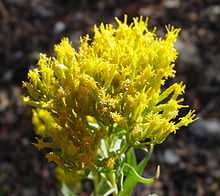Chrysothamnus
From Wikipedia, the free encyclopedia
| Chrysothamnus | |
|---|---|
 | |
| Chrysothamnus viscidiflorus | |
| Scientific classification | |
| Kingdom: | Plantae |
| (unranked): | Angiosperms |
| (unranked): | Eudicots |
| (unranked): | Asterids |
| Order: | Asterales |
| Family: | Asteraceae |
| Tribe: | Astereae |
| Genus: | Chrysothamnus Nutt. |
| Species | |
|
See text. | |
- For other species of rabbitbrush see Ericameria and Lorandersonia
Chrysothamnus (common names include rabbitbrush, rabbitbush, and chamisa) is a member of the plant family Asteraceae. The native distribution is in the arid western United States and northern Mexico. It is known for its bright white or yellow flowers in late summer.[citation needed]
Chrysothamnus species are used as food plants by the larvae of some Lepidoptera species including Coleophora linosyridella, Coleophora viscidiflorella (which have both been recorded on C. viscidiflorus) and Schinia walsinghami.[citation needed]
Species include:
- Chrysothamnus albidus - whiteflower rabbitbrush
- Chrysothamnus depressus - dwarf rabbitbrush, longflower rabbitbrush
- Chrysothamnus eremobius - pintwater rabbitbrush, remote rabbitbrush
- Chrysothamnus gramineus - Panamint rock rabbitbrush
- Chrysothamnus greenei - Greene's rabbitbrush
- Chrysothamnus humilis - Truckee rabbitbrush
- Chrysothamnus molestus - Arizona rabbitbrush
- Chrysothamnus vaseyi - Vasey's rabbitbrush
- Chrysothamnus viscidiflorus - yellow rabbitbrush
External links
This article is issued from Wikipedia. The text is available under the Creative Commons Attribution/Share Alike; additional terms may apply for the media files.